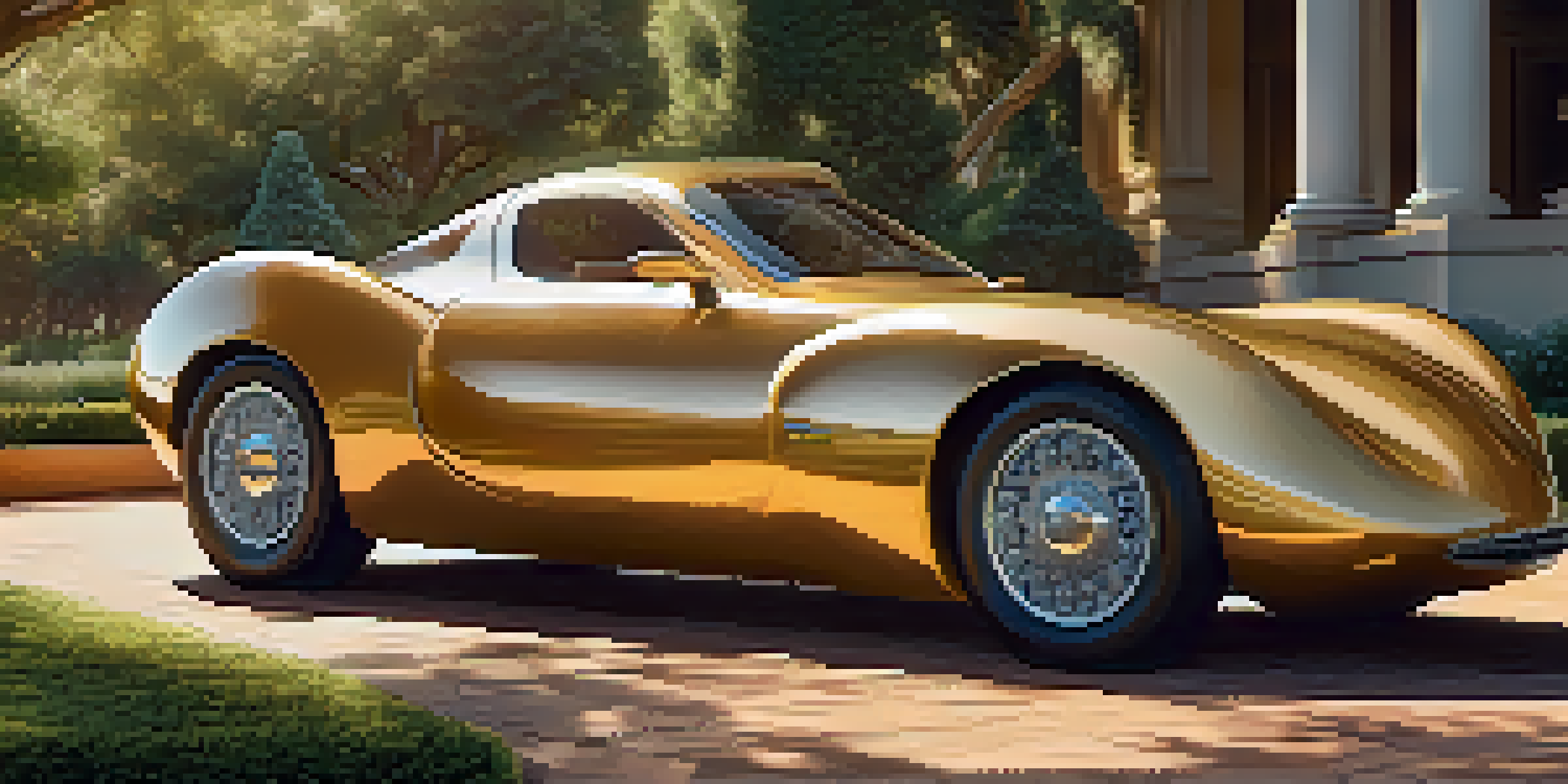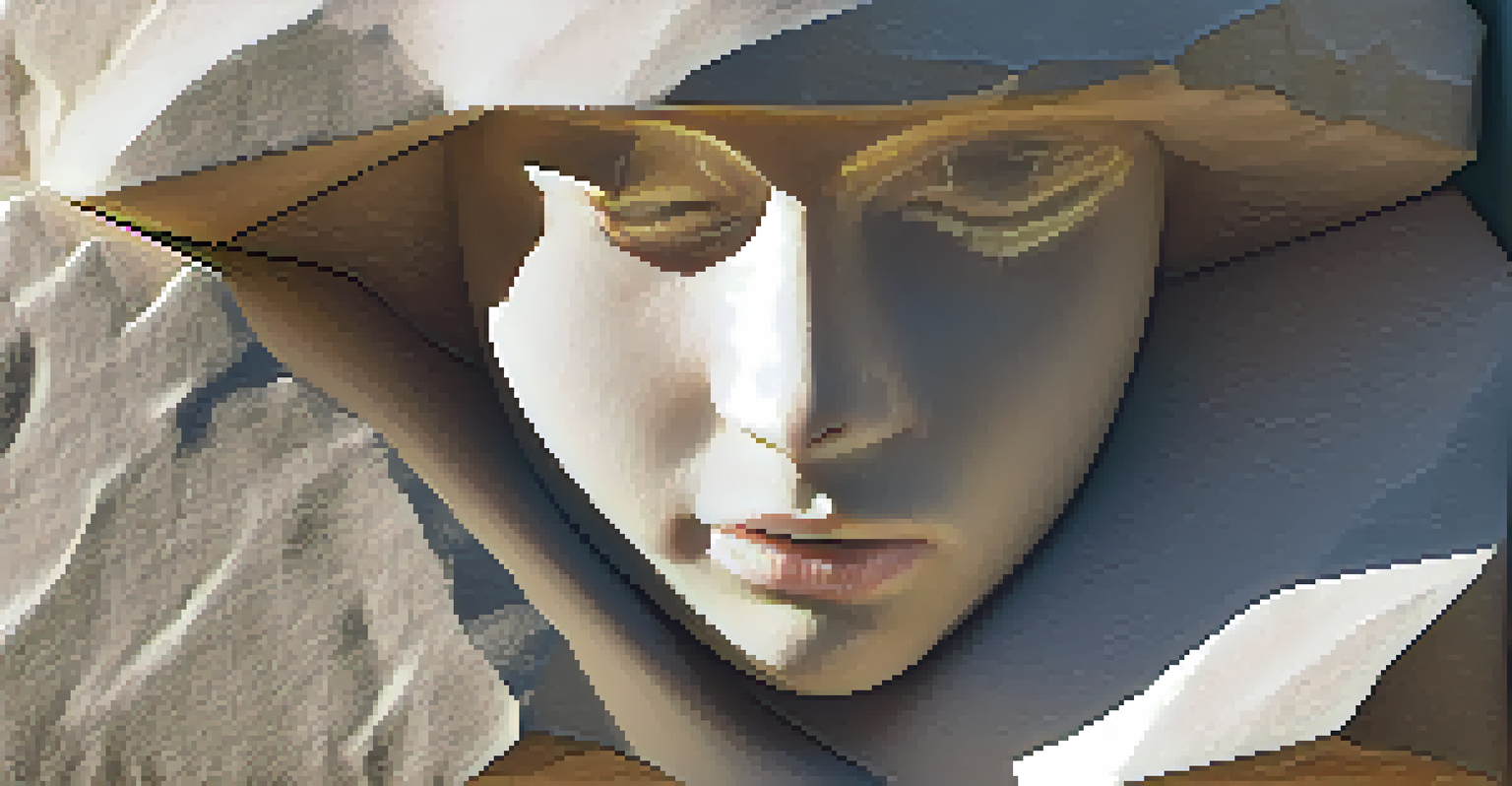The Impact of Light and Shadow on Sculpture and Carving Art

Understanding Light and Shadow in Art Forms
Light and shadow are fundamental elements that shape our perception of three-dimensional art forms, particularly in sculpture and carving. These elements create depth, contrast, and emphasis, allowing viewers to experience the artwork in a dynamic way. For instance, the way light hits a sculpture can transform its appearance throughout the day, making it a living piece of art that evolves with changing conditions.
Light is the greatest communicator of mood, emotion, and atmosphere.
The interplay between light and shadow can evoke emotions and create a narrative within the artwork. A well-placed light source can highlight certain features while obscuring others, guiding the viewer's focus and interpretation. This technique has been employed by artists throughout history, from ancient Roman sculptures to contemporary installations.
Moreover, understanding how light interacts with different materials is crucial for sculptors. For example, a polished marble surface reflects light differently compared to rough stone, influencing how the sculpture is perceived. This understanding allows artists to manipulate their medium to achieve the desired effect, enhancing the overall impact of their work.
The Role of Natural Light in Sculptural Art
Natural light plays a pivotal role in sculptural art, as it provides an ever-changing canvas for shadows to dance across surfaces. Outdoor sculptures, for instance, are subject to the shifting angles of sunlight throughout the day, creating a dynamic viewing experience. This relationship between sculpture and its environment can deepen the viewer's engagement with the piece.

Artists often consider the time of day and season when placing outdoor sculptures, knowing that natural light will enhance or alter the visual experience. For example, a sculpture may cast long shadows during sunrise or sunset, adding drama and intrigue that invites closer inspection. This intentional design choice can profoundly affect how the artwork is interpreted.
Light Transforms Sculptural Perception
The interplay of light and shadow enhances the depth and emotional impact of sculptures, allowing for a dynamic viewing experience.
Additionally, natural light can reveal textures and details that artificial lighting may overlook. Soft sunlight can illuminate subtle carvings and contours, allowing viewers to appreciate the craftsmanship involved. This connection to nature not only enhances the aesthetic appeal but also reinforces the idea that art is a part of the world around us.
Artificial Lighting: Enhancing Sculptural Experience
While natural light has its charm, artificial lighting offers sculptors complete control over how their work is perceived. By strategically placing lights, artists can create dramatic highlights and deep shadows, emphasizing particular aspects of their sculptures. This manipulation can breathe life into a piece, making it feel more vibrant and engaging.
Art is the most beautiful of all lies; it is a shadow of the truth.
For instance, spotlights can draw attention to a specific feature, such as a facial expression or intricate detail, while softer ambient lighting can create a more overall atmospheric effect. Many galleries and museums use such lighting techniques to enhance the viewer's experience and appreciation of the artwork. This careful curation helps to evoke a desired emotional response from the audience.
Moreover, artificial lighting allows for innovative presentations, such as illuminated sculptures or installations that change appearance based on lighting conditions. This flexibility can lead to immersive experiences that challenge traditional views on sculpture, inviting audiences to interact with art in new ways.
The Emotional Impact of Light and Shadow
Light and shadow do more than just enhance visual appeal; they also evoke emotions and convey messages within sculptural art. The way light falls on a piece can change its mood entirely; for example, harsh, direct lighting might create a stark, dramatic effect, while soft, diffused light can evoke feelings of warmth and intimacy. This emotional resonance is a powerful tool for artists.
Consider how a sculpture illuminated by a single spotlight might appear vulnerable and isolated, whereas the same piece bathed in even, ambient light could feel more approachable. This manipulation of light can guide the audience's emotional journey, making them feel a connection to the artwork and its creator. Artists can use these techniques to express underlying themes and narratives.
Natural vs. Artificial Lighting Effects
Natural light provides an ever-changing backdrop for sculptures, while artificial lighting offers artists control to create dramatic visual effects.
Additionally, shadows can serve as a metaphorical element within the artwork itself. By casting shadows that stretch or shrink, artists can represent concepts like time, memory, or the duality of existence. This added layer of meaning can deepen the viewer's engagement, prompting reflection and discussion long after they leave the exhibition.
Cultural Interpretations of Light and Shadow
Throughout history, different cultures have interpreted light and shadow in unique ways within their sculptural traditions. In many ancient civilizations, such as the Egyptians and Greeks, light was seen as a symbol of divinity and enlightenment, often reflected in their artistic choices. Sculptures were designed to catch the sun's rays, enhancing the spiritual connection between the artwork and its audience.
In contrast, some cultures may use shadow to invoke mystery or evoke the unknown. For example, in certain Asian art forms, the interplay of light and shadow can create a sense of tranquility and balance, reflecting philosophical ideals. Understanding these cultural interpretations can enrich our appreciation of sculptural art and its diverse meanings.
As globalization continues to influence art, contemporary sculptors draw inspiration from various cultural approaches to light and shadow. This fusion of ideas can lead to innovative techniques and perspectives that resonate with a broader audience. By examining these cultural narratives, we gain insight into how artists navigate and express their identities through light and shadow.
Techniques Artists Use to Manipulate Light and Shadow
Artists employ various techniques to manipulate light and shadow in their sculptures, enhancing the viewer's experience. One common approach is to use contrasting textures; for instance, a smooth surface may reflect light sharply, while a rough surface absorbs it, creating a dynamic visual effect. This contrast can draw attention to specific elements and create a sense of movement.
Another technique is the use of negative space, which refers to the empty areas around and between sculptural forms. By designing sculptures with intentional gaps, artists can allow light to filter through, casting intriguing shadows that add depth and complexity to the piece. This interaction between light and shadow invites viewers to explore the sculpture from multiple angles.
Cultural Views on Light and Shadow
Different cultures interpret light and shadow uniquely in their art, reflecting diverse philosophical and spiritual ideas.
Additionally, some artists experiment with materials that react to light in unique ways, such as transparent or reflective substances. These innovative choices can produce captivating effects that change with the viewer's perspective, making the artwork feel alive. This constant evolution of perception through light and shadow is a hallmark of modern sculptural practice.
The Future of Light and Shadow in Sculpture
As technology advances, the future of light and shadow in sculpture is poised for exciting developments. Artists are increasingly incorporating digital projection and interactive lighting into their work, creating immersive installations that challenge traditional notions of sculpture. These innovations can completely transform how we engage with and interpret three-dimensional art.
Moreover, sustainability is becoming a crucial consideration for artists. Many are exploring eco-friendly lighting options, such as solar-powered installations that utilize natural light to enhance their work. This shift not only reduces environmental impact but also encourages a deeper connection between art and the natural world.

Ultimately, the fusion of technology and traditional sculptural techniques will continue to shape the future of light and shadow in art. As artists experiment with new mediums and methods, we can expect to see even more captivating and thought-provoking pieces that invite audiences to engage with light and shadow in fresh ways.